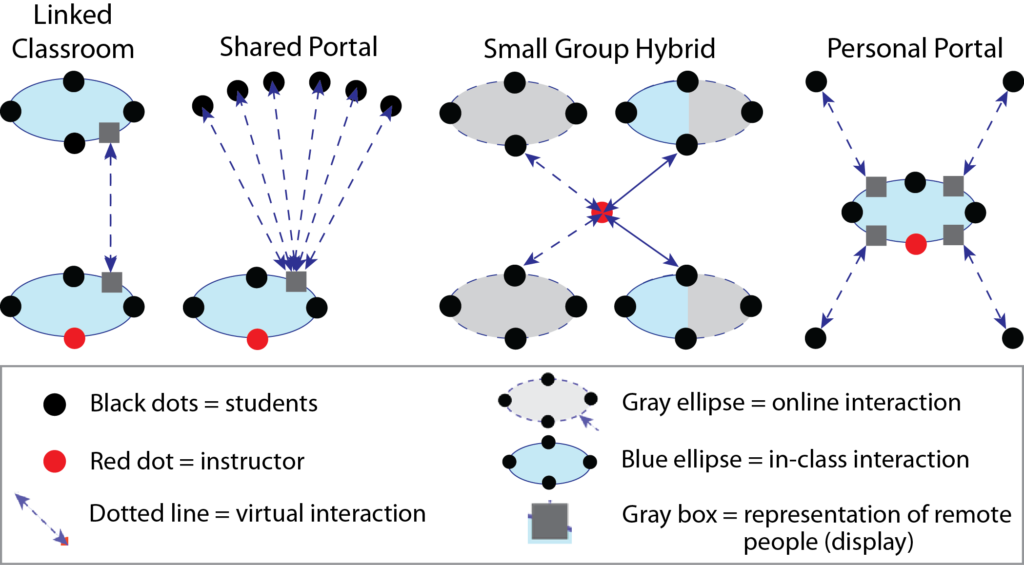hybrid learning experiences
problem
In 2010, the Educational Psychology and Educational Technology PhD program at Michigan State University launched it’s inaugural hybrid cohort: Half the students had an on-campus, face-to-face program experience while another half of the cohort participated online. In the first year of this hybrid program, online students only had the option to take online, asynchronous classes. This resulted in learning experiences that were “less than” their face-to-face peers’.
My team and I in the CEPSE Design Studio took on the challenge to design better online learning experience for our online students. Between 2011 and 2013, we partnered with faculty and experimented with technology to improve the quality of the online student experience.
opportunity
How might we make online learning experiences comparable to those face-to-face?
goal
Improve the quality of online learning experiences.
guiding principles
Experiment with technology.
We decided to to design learning experiences that brought together the online and face-to-face students at the same time: Hybrid learning experiences. To do that, we needed to find the right sets of technologies. We experimented with iPads on chairs and tripods, with Kubi robotic arms, and with different types of cameras, audio systems, and displays.

Align with course pedagogy.
In addition to the technology, we needed to consider the course pedagogy. Was the course a small seminar? Did it include a lot of small group work? Paired work? Where students on multiple campuses taking the course? Each course pedagogy was matched with its set of technologies.

Support the faculty.
The additional technology set up in the courses added an extra burden on the faculty members. Technical difficulties inadvertently would arise. As such, we experimented with a “Technology Navigator” program and had a design team member attend each hybrid class and manage the technologies, especially the online student learning experiences.

results
This work resulted in different technology models for hybrid learning, each aligning with a specific type of course pedagogy. We also presented and published on this work.
models for hybrid learning
Top left: Linked classroom. Top right: Shared portal. Middle: Small group hybrid. Bottom: Personal portal.




publications
Bell, J., Sawaya, S., & Cain, W. (2014). Synchromodal classes: Designing for shared learning experiences between face-to-face and online students. International Journal of Designs for Learning, 5(1), 68-82.
Sawaya. S., & Cain, W. (2014, March). Virtual presence in a synchromodal learning environment. Brief paper presented at the 25th annual meeting of the Society of Information Technology in Teacher Education (SITE). Jacksonville, FL.
Sawaya, S., Bell, J., & Cain, W. (2013, June). Introducing the personal portal model in a SynchroModal Learning Environment. Best practice paper presented at the annual meeting of the World Conference on Educational Media and Technology (EdMedia). Victoria, BC, Canada.
Cain, W., Sawaya, S., & Bell, J. (2013, June). Innovating the hybrid small group model in a SynchroModal Learning Environment. Best practice paper presented at the annual meeting of the World Conference on Educational Media and Technology (EdMedia). Victoria, BC, Canada.
Bell, J., Cain, W., Sawaya, S. (2013, June). Introducing the role of a Technology Navigator in a SynchroModal Learning Environment. Best practice paper presented at the annual meeting of the World Conference on Educational Media and Technology (EdMedia). Victoria, BC, Canada.
presentations
Cheng, C., & Sawaya. S. (2015, March). So Near Yet So Far Away: Transactional Distance in Synchronous Hybrid Learning Environments. Symposium presentation presented at the 26th annual meeting of the Society of Information Technology in Teacher Education (SITE). Las Vegas, NV.
Bell, J., Cain, W. & Sawaya. S. (2015, March). Common Ground in Uncommon Contexts: Towards a Topographic Language for Synchronous Blended/Multi-Access Learning Environments. Symposium presentation presented at the 26th annual meeting of the Society of Information Technology in Teacher Education (SITE). Las Vegas, NV.
Cain, W., Sawaya. S., & Bell, J. (2014, March). Introducing the linked classroom model in a synchromodal learning environment. Presented at the 25th annual meeting of the Society of Information Technology in Teacher Education (SITE). Jacksonville, FL.
Cain, W., Bell, J. & Sawaya, S. (2014, March). Supporting diffusion: Engaging the innovation-decision process for synchromodal class sessions. Presented at the 25th annual meeting of the Society of Information Technology in Teacher Education (SITE). Jacksonville, FL.
Bell, J., Sawaya, S., & Cain, W. (2013, June). Personal portals and synchromodal learning: Integrating face-to-face and online learners as comparable partners in the same learning experience. Presented at the Michigan State University Information Technology Conference. East Lansing, MI.
credits
Designing hybrid (or synchromodal) learning experiences in the College of Education at Michigan State University is the result of the hard work of many people in the CEPSE Design Studio and faculty members in the Ed Psych and Ed Tech program.